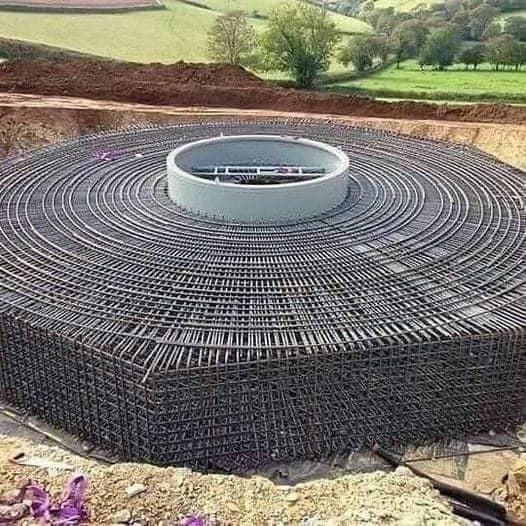Wind turbines are often celebrated as a green energy solution, touted as a way to reduce greenhouse gas emissions and move toward a more sustainable future. However, beneath the surface, the materials and processes required to construct these machines leave a substantial environmental footprint. Far from being the green energy panacea many assume them to be, wind turbines rely on resource-intensive materials, harmful production methods, and generate considerable waste, leading to long-term environmental damage.
So that leaves the question, “What are the damaging environmental impacts of wind turbine materials and size of their underappreciated carbon footprint?”
Wind Turbine Materials: The Foundation of Environmental Damage
At the core of the wind turbine industry’s environmental toll are the materials used to build these towering machines. Steel, fiberglass, copper, rare earth metals, and concrete are all essential for their construction. Each of these materials carries significant carbon costs, which undermine the clean energy narrative.
Steel: High Carbon Emissions from Production
Steel is one of the most critical materials for wind turbines, particularly for the towers and nacelles. Producing steel, however, involves energy-intensive processes, including mining iron ore and using coke (a coal byproduct) in the steel-making process. Steel manufacturing is responsible for a staggering 7-9% of global greenhouse gas emissions.
Building a wind turbine can require hundreds of tons of steel, further amplifying the carbon footprint. Transportation to often remote wind farm locations adds more CO2 emissions, as heavy steel components must be shipped over long distances.
Fiberglass and Carbon Fiber: Non-Recyclable and Petroleum-Based
Wind turbine blades are typically made of fiberglass or carbon fiber, both of which are petroleum-based materials. The production of these composite materials is not only energy-intensive but also creates non-recyclable waste. Turbine blades have a lifespan of about 20-30 years, after which they are often discarded in landfills, contributing to growing waste management problems.
It is estimated that thousands of decommissioned turbine blades are currently sitting in landfills, and this number will only grow as more wind farms age. The irony is clear: a green energy solution that generates substantial, non-biodegradable waste is anything but sustainable.
Rare Earth Metals: Toxic Mining and Environmental Catastrophe
Perhaps the most environmentally destructive aspect of wind turbine construction is the use of rare earth metals, such as neodymium and dysprosium, for the magnets in turbine generators. The mining of rare earth metals is notorious for causing severe ecological damage, particularly in countries with lax environmental regulations like China, where most of these metals are sourced.
Rare earth mining often results in soil erosion, water contamination, and habitat destruction. In some regions, vast areas have become toxic wastelands due to the pollution caused by extracting these critical materials. The environmental cost is immense, and as demand for wind turbines increases, so too will the destructive mining practices that supply the rare earth metals needed to produce them.
Copper: An Energy-Intensive and Environmentally Damaging Material
Copper, used extensively in wind turbine wiring and electrical components, has its own environmental challenges. While copper is theoretically recyclable, mining this metal still leads to significant environmental destruction. Deforestation, soil degradation, and water pollution are common consequences of copper mining operations, particularly in countries like Chile, where the depletion of water resources is now a critical issue.
Beyond mining, the energy-intensive process of refining copper adds even more CO2 to the atmosphere, further inflating the carbon footprint of wind turbines.
Concrete: A Major Polluter
Wind turbine foundations require large amounts of concrete, which is one of the most environmentally harmful construction materials in use today. The production of cement, the key ingredient in concrete, is responsible for around 8% of global carbon dioxide emissions.
Building just one large wind turbine can require hundreds of tons of concrete, further exacerbating the environmental toll. The widespread use of concrete in wind farm construction contributes significantly to the overall carbon emissions associated with wind power.
The Massive Carbon Footprint of Wind Turbine Materials
While wind turbines generate “clean” electricity, their embodied carbon—the total amount of CO2 emissions produced during the extraction, manufacturing, and transportation of materials—paints a different picture.
It’s estimated that the carbon footprint of a wind turbine can range from 10-15 grams of CO2 per kilowatt-hour (gCO2/kWh) of electricity generated. While this is less than fossil fuel-powered plants, it is far from negligible source. This figure only accounts for the operational phase and often overlooks the massive CO2 emissions produced during the construction, maintenance, and decommissioning of wind turbines.
In addition to the high carbon costs associated with manufacturing, transporting wind turbines to their installation sites, particularly offshore, results in further environmental degradation. The construction of offshore wind farms, for example, involves using ships and cranes that rely on fossil fuels, undermining the very premise of green energy.
The Recycling Problem: Wind Turbine Waste Is Growing
One of the most significant challenges facing the wind energy industry is the end-of-life disposal of turbines. As more turbines are decommissioned after decades of service, the issue of recycling or disposing of components becomes more pressing. Unfortunately, many turbine materials, particularly fiberglass blades, are not easily recyclable.
Currently, most retired blades are discarded in landfills, and the rate of turbine waste is expected to increase exponentially in the coming years. According to industry estimates, over 43 million tons of wind turbine blades will be decommissioned globally by 2050, creating a massive waste problem.
Moreover, recycling rare earth metals used in turbine generators is technically challenging and expensive, limiting efforts to recover these valuable resources at the end of their life cycle. Without comprehensive recycling programs in place, wind turbine waste will continue to grow, contributing to long-term environmental harm.
Wind Turbines Are Not the Green Solution We Need
While wind energy has long been championed as a key tool in the fight against climate change, the reality is far more complex. The materials required to construct wind turbines—steel, fiberglass, rare earth metals, copper, and concrete—come with significant environmental costs that should not be ignored. The production processes for these materials involve intensive energy use, widespread pollution, and unsustainable waste disposal practices.
Given the massive carbon footprint of wind turbine materials and the growing problem of turbine disposal, it’s clear that wind energy is not the perfect solution it is often made out to be. As the world seeks truly sustainable alternatives to fossil fuels, it is time to reconsider the environmental trade-offs of wind turbines and explore more responsible, less destructive ways to generate energy.
Sources
- World Steel Association. (n.d.). Steel and the Circular Economy Fact Sheet. https://www.worldsteel.org/en/dam/jcr:bc7bd9e1-e1de-4d0d-b1eb-5f53b3b3fc76/Steel%20and%20the%20circular%20economy%20fact%20sheet.pdf
- Bloomberg. (2020). Wind Turbine Blades Can’t Be Recycled, So They’re Piling Up in Landfills. https://www.bloomberg.com/news/features/2020-02-05/wind-turbine-blades-can-t-be-recycled-so-they-re-piling-up-in-landfills
- The Guardian. (2012). Rare Earth Mining in China: The Toxic Legacy of a Modern Industry. https://www.theguardian.com/sustainable-business/rare-earth-mining-china-toxic-legacy
- Reuters. (2020). Copper Mining’s Heavy Toll on Water Resources in Chile. [https://www.reuters.com/article/us-chile-mining-water-insight-id

